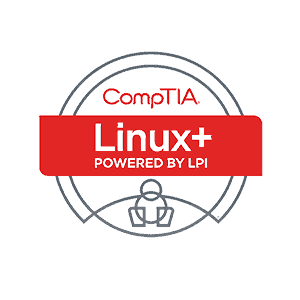Linux Plus

Class Overview
CompTIA Linux Plus
CompTIA Linux Plus (also known as Linux+) 5-day training class is designed to provide early-career systems administrators with the knowledge to configure, optimize, operate, and troubleshoot Linux operating systems.
This class prepares the student to sit the CompTIA Linux Plus exam.
Class Details
Linux Plus (Linux ) Training for CompTIA Certification
Class Objectives
Upon successful completion of this class, students should be able to:- Identify basic Linux concepts and perform basic Linux tasks
- Manage user and group accounts
- Manage partitions and the Linux filesystem
- Manage various files in Linux
- Work with Linux permissions and ownership
- Print files
- Manage package
- Manage kernel services
- Work with the Bash shell
- Manage jobs and processes
- Manage system services
- Configure Linux services to provide users with network connectivity
- Configure basic Internet services
- Implement measures to secure a Linux system
- Manage hardware associated with Linux systems
- Troubleshoot Linux system issues
- Install the Linux operating system
- Configure the GUI
Pre-Requisite Knowledge Advisory
- CompTIA A
- CompTIA N
- At least 1 year of Linux administration experience
Exam Required for CompTIA Linux Certification
To gain Linux Plus certification, the student must pass the following exam:- Exam XK0-005
Duration of exam: 90 minutes (90 questions) each
Passing Score: 720 (on a scale out of 900)
Linux Plus (Linux ) Class Outline
Module 1: Familiarizing Yourself with Linux
- Review the History and Development of Linux
- Enter Shell Commands
- Get Help Using Linux
- Start and Stop Linux
Module 2: Managing User and Group Accounts
- Create User and Group Accounts
- Configure User Profiles
- Manage User and Group Accounts
Module 3: Managing Partitions and the Linux Filesystem
- Create Partitions
- Navigate through the Linux Filesystem
- Manage the Filesystem
- Maintain the Filesystem
Module 4: Managing Files in Linux
- Create and Edit Files
- Locate Files
- Search Text Using Regular Expressions
- Apply Filters to Text Streams
- Link Files
- Back Up and Restore Files
- Manage Databases Using MySQL
Module 5: Working with Linux Permissions and Ownership
- Modify File and Directory Permissions
- Modify Default Permissions
- Modify File and Directory Ownership
- Set Advanced Permissions
Module 6: Printing Files
- Configure a Local Printer
- Print Files
- Manage Print Jobs and Queues
- Configure Remote Printing
Module 7: Managing Packages
- Manage Packages Using RPM
- Verify Packages
- Upgrade Packages
- Configure Repositories
- Manage Packages Using YUM
- Manage Packages Using the Debian Package Manager
- Manage Packages Using Source Files
- Manage Shared Libraries
Module 8: Managing Kernel Services
- Explore the Linux Kernel
- Customize Kernel Modules
- Create an initrd Image
- Manage Device Drivers
- Monitor Hardware Devices
- Monitor Processes and Resources
Module 9: Working with the Bash Shell and Shell Scripts
- Perform Basic Bash Shell Operations
- Introduction to Shell Scripting
- Customize the Bash Shell
- Redirect Standard Input and Output
- Use Control Statements in Shell Scripts
Module 10: Managing Jobs and Processes
- Manage Jobs and Background Processes
- Manage Processes Using the Process Table
- Examine Delayed and Detached Jobs
- Schedule Jobs
- Maintain the System Time
Module 11: Managing System Services
- Configure System Services
- Monitor System Logs
- Configure SELinux
Module 12: Configuring Network Services
- Connect to a Network
- Configure Routes
- Configure Client Network Services
- Manage Remote Network Systems
Module 13: Configuring Basic Internet Services
- Configure Email Services
- Control Internet Services
Module 14: Securing Linux
- Examine the Basics of System Security
- Secure User Accounts
- Enable Firewall Functionality
- Implement Security Auditing
- Describe the Intrusion Detection System
Module 15: Managing Hardware
- Identify Common Hardware Components and Resources
- Configure Removable Hardware
- Configure Disk Quotas
Module 16: Troubleshooting Linux Systems
- Troubleshoot System-Based Issues
- Troubleshoot Hardware Issues
- Troubleshoot Network Connection and Security Issues
Module 17: Installing Linux
- Prepare for Installation
- Identify Phases of the Linux Boot Sequence
- Configure GRUB
- Install the Operating System
- Perform Post-Installation Tasks
Module 18: Configuring the GUI
- Implement X
- Customize the Display Manager
- Customize the Window Environment
- Enable Accessibility Settings in Linux
Have questions?
Ready to find to get started?
Important Notice: NC-Expert does not accept enrollment applications from independent individuals. We require that employers pay for their employees. We continue to service corporate clients, using B2B transactions, with no change in service. We apologize for any inconvenience.
Our vision is to provide innovative, relevant, and accessible technical consulting and training for executives and engineers which will enable them to directly impact the growth of their companies.
Get In Touch
+1 (855) 941-2121
5113 Johnson Dr
Pleasanton, CA 94588
sales@nc-expert.com
Quicklinks
Let's Talk
NC-Expert - All Rights Reserved


